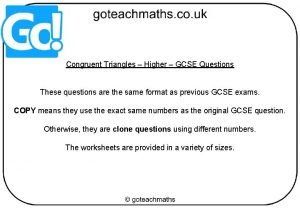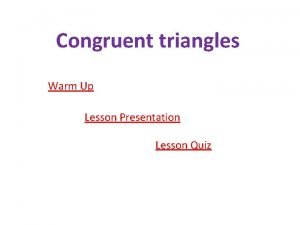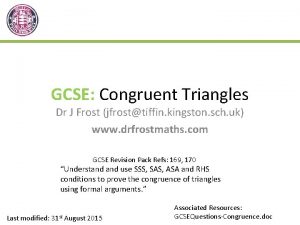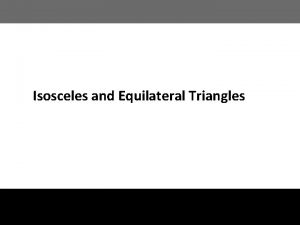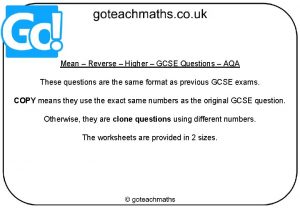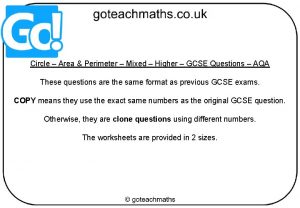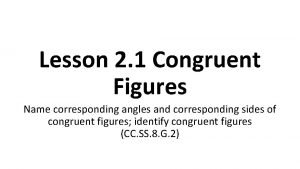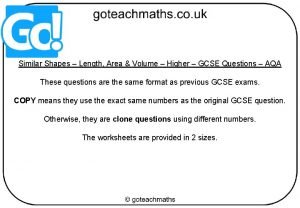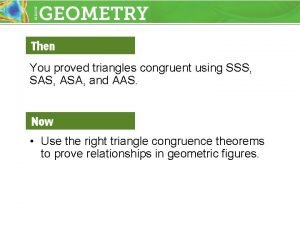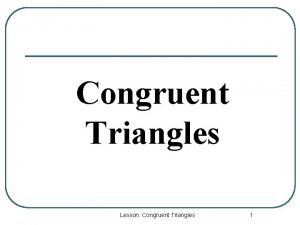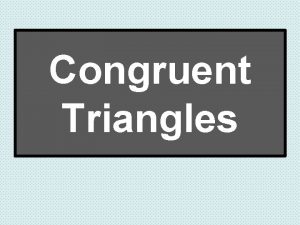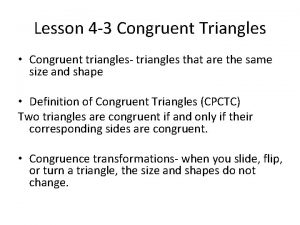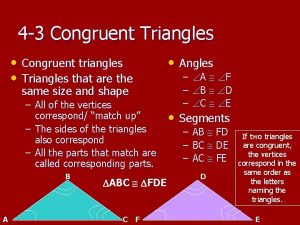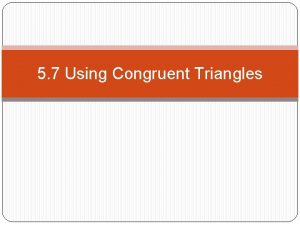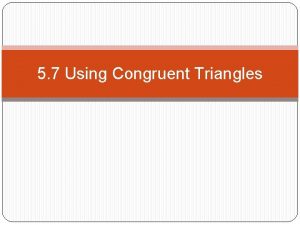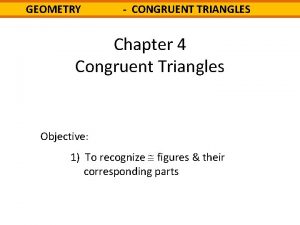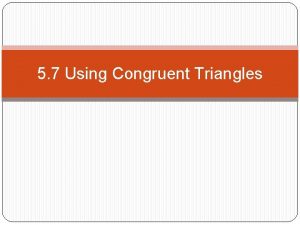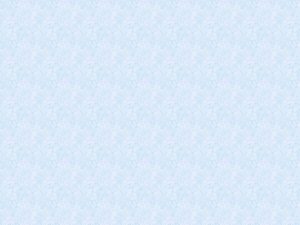Congruent Triangles Higher GCSE Questions These questions are











- Slides: 11

Congruent Triangles – Higher – GCSE Questions These questions are the same format as previous GCSE exams. COPY means they use the exact same numbers as the original GCSE question. Otherwise, they are clone questions using different numbers. The worksheets are provided in a variety of sizes.

Printing To print handouts from slides Select the slide from the left. Then click: File > Print > ‘Print Current Slide’ To print multiple slides Click on a section title to highlight all those slides, or press ‘Ctrl’ at the same time as selecting slides to highlight more than one. Then click: File > Print > ‘Print Selection’ To print double-sided handouts Highlight both slides before using ‘Print Selection’. Choose ‘Print on Both Sides’ and ‘Flip on Short Edge’.

GCSE 1 GCSE Edexcel Higher: May 2017 Paper 1, 21 ABCD is a quadrilateral. D C DA = CB A Angle DAB = angle ABC Prove that AC = DB. 1 Edexcel Higher: May 2017 Paper 1, 21 ABCD is a quadrilateral. D DA = CB A Angle DAB = angle ABC Prove that AC = DB. B (Total for Question 1 is 4 marks) GCSE 1 DA = CB A Angle DAB = angle ABC Prove that AC = DB. C B (Total for Question 1 is 4 marks) GCSE Edexcel Higher: May 2017 Paper 1, 21 ABCD is a quadrilateral. D C 1 Edexcel Higher: May 2017 Paper 1, 21 ABCD is a quadrilateral. D DA = CB A Angle DAB = angle ABC Prove that AC = DB. C B (Total for Question 1 is 4 marks)


GCSE Edexcel Higher: June 2018 Paper 3, Q 21 A 1 B T A 1 S C Edexcel Higher: June 2018 Paper 3, Q 21 B T D S C D ABCD is a parallelogram. ABS and TCD are straight lines. Angle TBD = angle ACS = 90° (a) Prove that triangle TBD is congruent to triangle ACS. (3) (b) Explain why AT is parallel to SD. (2) (Total for Question 1 is 5 marks)


GCSE 1 Edexcel Higher: May 2017 Paper 1, 21 ABCD is a quadrilateral. D DA = CB A Angle DAB = angle ABC Prove that AC = DB. C B (Total for Question 1 is 4 marks)

GCSE Edexcel Higher: June 2018 Paper 3, Q 21 A 1 B T S C D ABCD is a parallelogram. ABS and TCD are straight lines. Angle TBD = angle ACS = 90° (a) Prove that triangle TBD is congruent to triangle ACS. (3) (b) Explain why AT is parallel to SD. (2) (Total for Question 1 is 5 marks)

GCSE 1 Edexcel Higher: May 2017 Paper 1, 21 ABCD is a quadrilateral. D C DA = CB A B Angle DAB = angle ABC Prove that AC = DB. Prove 2 triangles DAB, ABC are congruent. Angle DAB = angle ABC DA = CB (ANGLE) (SIDE) AB is shared by both triangles. (SIDE) Both triangles are congruent (SAS). So, AC must = DB (Total for Question 1 is 4 marks)

GCSE Edexcel Higher: June 2018 Paper 3, Q 21 A 1 B T S C D ABCD is a parallelogram. ABS and TCD are straight lines. Angle TBD = angle ACS = 90° (a) Prove that triangle TBD is congruent to triangle ACS. Angle TBD = Angle ACS (given) AC = BD (opposite sides of parallelogram are equal) Angle TDB = Angle SAC (opposite angles of a parallelogram are equal) Therefore, triangles have angle-side-angle the same, ASA: they are congruent (3) (b) Explain why AT is parallel to SD. TBD is congruent to ACS, so AS = TD AS & TD are parallel ASDT is therefore a parallelogram. Opposite sides of a parallelogram are parallel. (2) (Total for Question 1 is 5 marks)

Questions? Comments? Suggestions? …or have you found a mistake!? Any feedback would be appreciated . Please feel free to email: tom@goteachmaths. co. uk
 Congruent triangles gcse
Congruent triangles gcse Insidan region jh
Insidan region jh Proving triangles congruent quiz
Proving triangles congruent quiz Dr frost congruent triangles
Dr frost congruent triangles 4-4 the isosceles triangle theorems
4-4 the isosceles triangle theorems Gcse ratio questions higher
Gcse ratio questions higher Reverse mean higher gcse questions and answers
Reverse mean higher gcse questions and answers Area and perimeter gcse exam questions higher
Area and perimeter gcse exam questions higher A polygon with six congruent sides and six congruent angles
A polygon with six congruent sides and six congruent angles Corresponding angles
Corresponding angles Similar shapes gcse questions
Similar shapes gcse questions Flow proof geometry
Flow proof geometry
